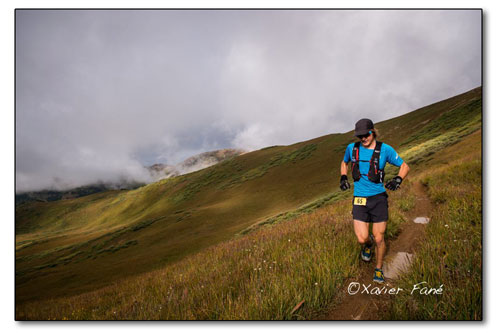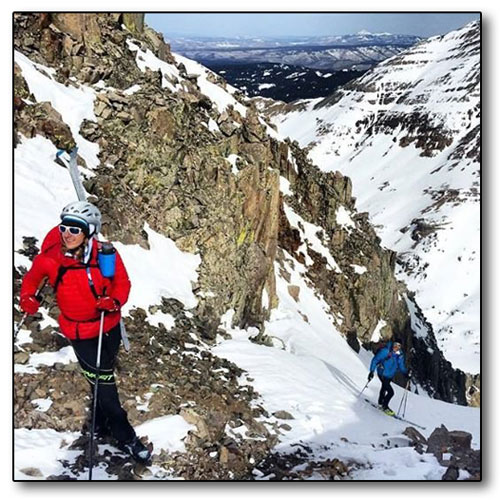
Durango’s Brendan Trimboli en route to winning the Summer GT run in 2015. Trimboli earned $500 for his King of the Mountain prize for reaching the top of Star Pass first. On where he spent the money, Trimboli says, “some of it went toward that really nice New Year’s Eve dinner with my sweetheart. We got the full-on seven course meal with wine pairing at Eolus. It was, like, $350.”/Photo by Xavier Fané
Banana belt badasses
Grand Traverse’s triple crown goes to the dudes down south
by Joy Martin
Durango: where good days end with high fives, big smiles and recaps over cold beer. Where athletes and outdoor enthusiasts flock to play, train and push themselves to their limits – or leisurely float the river. Where there’s always someone stronger, faster, more adept than you. And where most of the time that just doesn’t really matter.
“People live for it,” says skier, runner and biker Paul “Tall Paul” Hamilton of Durango’s obsession with the great outdoors. “It’s a lifestyle. Not just recreation. It’s what defines the culture of Durango: just being outside and enjoying the landscape with your friends.”
But sometimes, good ole fashioned competition just feels oh-so-nice as victory presses proud, cheeky grins across our tan, happy faces. Especially when our little, high-desert nook is pitted against the big, shiny mountain towns of the north. Like that time in 2015 when Durango athletes swept the triple crown of the legendary Grand Traverse.
The Grand Traverse, a notorious 40-mile race across the Elk Mountains, was first launched as a ski mountaineering event in 1998 and in the last two years expanded to include a summer edition that features trail running and mountain bike portions. When a racer completes all three, he or she earns the bragging rights of the triple crown.
In the macro-community picture though, 2015 marked the year focused not on individual accomplishments but rather the fact that all three races were won by our very own southern stock of Durangoans. It’s something unheard of in years past, considering the wins usually go to the predictable high-altitude heavy hitters, those super-elevation freaks of nature from the northern mountain towns, bullies of the endurance world who are just too damned good at everything.
“A 40-mile race between two ski towns in the night?!” laughs the Summer Grand Traverse winner of the trail run, Brendan Trimboli. “Several years ago, it sounded completely crazy and seemed like something I’d probably never do. As luck may have it, I ended up in Durango, hanging out with the right people – or the wrong people – realizing you can actually do things like this.
 Scott Simmons and “Tall Paul” Hamilton on a winter training sesh for the 2015 GT. The two finished the epic 40-mile course in a blistering 6 hours and 44 minutes./Courtesy photo |
“Now, the Grand Traverse has officially become a household name in the endurance community,” says Trimboli. “And Durango just came in and swept the triple crown.”
Trimboli, an energy analyst, race organizer and president of the Durango Running Club, ran the summer route in six hours and 25 minutes, slightly faster than Scott Simmons and Paul Hamilton skied the winter course at their record-breaking speed of six hours and 44 minutes. Local rider Payson McElveen, meanwhile, cranked out the mountain bike win in four hours and 17 minutes. All four of these strong, skinny blokes are dedicated, disciplined, determined and downright stoked on anything outside. They are ... so Durango.
“The epic adventures we get into seem like craziness to 99 percent of the population,” says Trimboli. “But when you’re in Durango, it’s normal. There are pros and cons to living around a bunch of badass people. It’s inspiring.”
And it’s exhausting.
Trimboli, who also skied the 2014 and 2015 Winter Grand Traverses, was two-for-three on his way to earning the triple crown last year. He’s not participating in this year’s ski event but plans on participating in the third annual Summer Grand Traverse run and bike races.
“I’d seen it in the dark under a snowy landscape in moonlight on skis and all I wanted was to see it in fall with the colors,” says the 28-year-old. “Turns out that it’s less intimidating in daylight. In the trail race, I wasn’t concerned about getting down the hill in one piece.”
The 18th annual Winter Grand Traverse kicks off Fri., March 25, at the stroke of midnight, when hundreds of spandex-clad, headlamp-bedecked skiers in teams of two will glide, slide, grunt, grind, post-hole, shiver and suffer their way from Crested Butte to Aspen, gaining a total of 7,800-feet and taking anywhere from eight to 16 hours to finish, or, if you’re from Durango, less than the time it takes to drive to Denver.
Last year, constellations looked on as long legs and iron lungs carried Simmons and Hamilton up, over and through the night. They crested Richmond Hill as the sun rose before bombing down Aspen Mountain to the finish line, where race organizers weren’t quite prepared to see the stalwart duo for at least another hour or so.
“Topping out on Aspen Mountain, realizing our hard work had paid off and we’d crushed it,” says Simmons of his favorite part of the race. “But then as we were coming into the finish, I couldn’t avoid this hose laying across the middle of the chute.”
“Scott doesn’t fall really,” Hamilton continues. “He’s such a strong skier. But within 10 meters of the finish, he catches his ski on something and falls flat on his face, sliding across the finish. I see it out of the corner of my eye and stop across the line to look at him squirming on the ground in discomfort and pain … He can’t breathe. We thought he’d broken a rib. Eventually, he stood up and caught his breath. And then he just let out this primal yell.”
“I think I was crying,” says the heavily bearded Simmons.
For 44-year-old Simmons, the win marked his fourth and potentially final Grand Traverse attempt, while the race was 29-year-old Hamilton’s first. In March 2016, the boys completed the Pierra Menta in France and the first known winter attempt of the Hardrock 100 course in the San Juan Mountains – both events within a week of each other.
When asked if the pair would be racing the Grand Traverse this weekend, Simmons just chuckles and Hamilton doesn’t hesitate to nearly shout a resounding “HELL NO!” Forceful words from a typically taciturn young man.
“I’m not getting back in my ski boots till next winter,” says Hamilton.
Simmons says he’ll probably never do another Grand Traverse. Probably. He’s always wanted to do it with his son, Quinn, but Quinn’s obsessed with biking nowadays, says Simmons.
So next up for Simmons is the Iron Horse Bicycle Classic in May.
“The only reason I’m doing it is because Quinn’s doing it,” says Simmons, who’s thinking 14-year-old Quinn might burn out on biking and come back to skiing someday.
But if Quinn doesn’t come back to skiing, there’s always the Summer Grand Traverse run and bike races, which feature the same 40-mile course from Crested Butte to Aspen. Now, endurance athletes can test their mettle running the 7,800-feet of elevation gain in daylight, while mountain bikers can make the return effort from Aspen to Crested Butte the next day.
The 2015 win for the Summer Grand Traverse Bike Race went to young buck McElveen, a professional mountain biker and senior at Fort Lewis College.
“I’m not a skier,” says McElveen, who has no interest in obtaining the three jewels of the triple crown. “I mean, I’m from Texas. And the farthest I’ve run is, like, 10 miles.”
But, boy, can he ride.
“I pretty much turned myself inside out to stay on Payson’s tail,” laughs Simmons, recalling the first time McElveen joined a group ride one night to High Point on the Colorado Trail.
For McElveen, the lowest point of the Grand Traverse trail was the first 30 minutes, when he wasn’t confident he could ride away with the win as one of those northern-mountain bullies, Brian Smith, charged up the climb to claim King of the Mountain.
But despite technical, muddy conditions, McElveen’s bike stayed in one piece, and eventually Smith ate his dust, with McElveen cruising to a win and the $500 first place prize money.
“That’s a solid pay out,” laughs McElveen, who says all of the money went straight to his savings account.
“It was fun,” says the 23-year-old. “Unlike anything I’d ever done. Unsanctioned, not a lot of media coverage, not a lot of spectators, but of all the races I did last year, this one brought the most notoriety because it’s such a legendary event. Satisfying to come away with the win after being pushed by Mr. Smith. Knowing more, I’ll go back this year for sure. After all, it’s only growing in popularity and power.”
As is Durango. We might be drier, browner, dustier and a little rougher around the edges, but we sure know how to play hard and sometimes win big. So congratulations to all Durango athletes out there making us look good – see you on the river with a cold beer and a high five.
